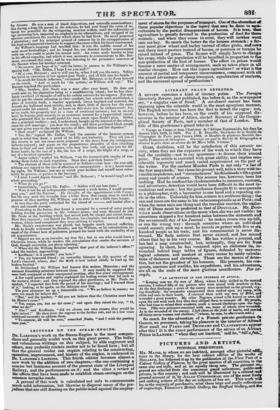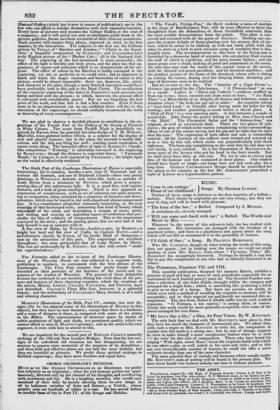PICTURES AND ARTIST'S.
PICTORIAL PERIODICALS. •
MR. MAJOR, to whom we are indebted, amongst other pictorial adis,, tions to the library, for the best cabinet edition of the works or HOGASTH, has followeditop by the .publication of the First Part of a Cabinet Gallery of Pictures, by the great masters of all countries, in the -same size and style and at an equally cheap rate. The pieturee. en, graved are selected from the numerous grand collections, Rubliewndc private in this country.; and eac.h will be illustrated by a entioal-wwl: general of it, by ALLAN CUNNINGHAM; one of the most and striking writers of the day on subjects of fine art. This work be, to the majority of purchasers, what those large and costly collections of engravings, TOMEINS'S British Gallery, the Staffcr4 Gallery, and-the National Gallery (which last is now in course of publication), are to the few who can afford to indulge themselves with such expensive luxuries. Every lover of pictures may possess the Cabinet Gallery at the cost of a magazine ; and it will prove not only an intelligent guide-book to the picture galleries, buten excellent memorial of their choicest ornaments. Each number will contain three. plates, engraved on steel, in the line manner, by the best artists. The subjects in the first are the brilliant picture by TITIAN of " Bacchus and Ariadne ;" " Christ in the Sepul- chre," a beautiful composition by GUERCINO ; and GAINSBOROUGH'S truly English picture of the "Market Cart ;" all in the National Gal- lery. The engraving of the last-mentioned is most successful ; the effect of the light is forcibly and truly given, and the plate has that ap- pearance of repose and seclusion which is so characteristic of the ori- ginal. The effect of colour in the Bacchus is boldly conveyed in the engraving, yet not so perfectly as we could wish ; but to represent in black and white the magic contrasts and harmonies of colour in this picture, would be almost impossible : there are, however, life, spirit, and character in the plate, though a more finished execution would have been preferable, both in this and in the Dead Christ. The recollection of the exquisite engraving of the latter in TOMKINS'S work prevents our being satisfied with the present ; in which, however, the general effect is conveyed with considerable power. But we are forgetting the low price of the work, and that this is but a first number. Even if there were to be no improvement (as we are confident there will be) in the execution of the engravings, we should cordially recommend the work as deserving of every encouragement.



























 Previous page
Previous page